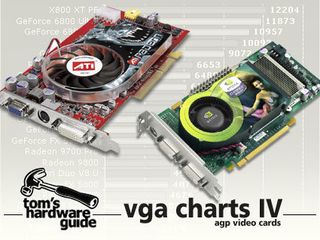VGA Charts IV: AGP Graphics Cards
Introduction

After nearly 10 months, we're back again with an updated version of THG's VGA Charts. This time around, not quite as many new products were launched in 2004. While an abundance of new products flooded the market in 2003, the two market leaders ATI and NVIDIA held back this year, at least with respect to the number of products launch. At the same time, performance-wise, both graphics processor makers have made great strides with their enthusiast line of products. The performance leap, in fact, was almost desperately needed, as games continue to become more and more demanding with ever-intensifying use of pixel and vertex shaders.
This is what we had to consider when selecting games and benchmarks to use for the test. In addition to well-known, pure benchmark applications such as 3D Mark 2003 and AquaMark 3, we also try to bring in the widest range of game genres, popular titles and games that are technically demanding with regard to 3D. For testing, we either used the benchmark mode built into the game or carried out gaming measurements "manually" with the help of the tool FRAPS. The margin of error for these measurements is very low, less than 1FPS.
The Source Video Benchmark, which Valve recently released and whose performance offers a glimpse of how fast the eagerly-awaited Half Life 2 will run, is unfortunately inappropriate for the VGA Charts. The game is still in the beta stages and constantly downloads new updates through Valves's "Steam" client software. It would have been impractical to use this as a common test platform for all cards, since the testing process for the VGA Charts lasts for a few weeks, and we'd have to start from the beginning with each update. Even the newly released benchmark 3D Mark 2005 arrived too late to be included in the Charts. Anyway, 3D Mark 2005 is problematic because of the driver situation with ATI and NVIDIA, which brings us to our next topic.
Stay on the Cutting Edge
Join the experts who read Tom's Hardware for the inside track on enthusiast PC tech news — and have for over 25 years. We'll send breaking news and in-depth reviews of CPUs, GPUs, AI, maker hardware and more straight to your inbox.
Most Popular

